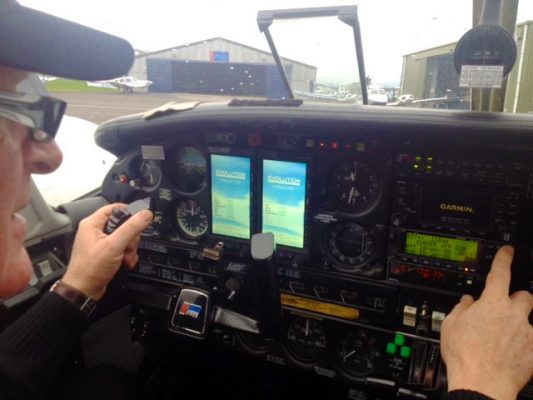[vc_row][vc_column][vc_column_text]Atlantic Flight Training Academy’s ‘senior’ twin training aircraft, Piper Seneca EI CMT, recently had a nice new paint-job and a glass panel fitted. EI-CMT is one of AFTA’s four Piper Seneca twin training aircraft. The upgraded panel is an ASPEN Evolution 1500 display system. Two screens provide primary flight instruments one side with maps and charts on the other side.[/vc_column_text][vc_single_image image=”211″ border_color=”grey” img_link_large=”” img_link_target=”_self” img_size=”full”][vc_column_text]Gerry is no stranger to glass cockpits having flown the Harrier GR7 in the RAF which had multi-function displays. Later he was responsible for overseeing MoD research and development into future cockpit design. Early glass cockpits tended to be expensive, and driven by the need to display lots of information in a limited space. Much work has been done to make displays intuitive and easy to operate. Today, ‘glass’ displays are actually much less expensive to install and maintain , they have no moving parts and are ultra reliable.[/vc_column_text][vc_single_image image=”208″ border_color=”grey” img_link_large=”” img_link_target=”_self” img_size=”full”][vc_column_text]Gerry accepts the newly instrumented Seneca EI CMT from Alec Vincent, Chief Avionics Engineer, of RGV Aviation.[/vc_column_text][vc_single_image image=”205″ border_color=”grey” img_link_large=”” img_link_target=”_self” img_size=”full”][vc_column_text]First time start-up and familiarisation.[/vc_column_text][vc_single_image image=”209″ border_color=”grey” img_link_large=”” img_link_target=”_self” img_size=”full”][vc_column_text]Aspen’s ‘Evolution 1500’ system. Flight instruments on the left, selectable displays on the right (traffic, terrain and moving map here).[/vc_column_text][vc_single_image image=”210″ border_color=”grey” img_link_large=”” img_link_target=”_self” img_size=”full”][vc_column_text]The right hand screen can display a variety of maps and charts. Here it shows the aircraft outside the RGV hangar on the ground in Gloucester while Gerry and Barry explore the new ‘kit’.[/vc_column_text][vc_single_image image=”207″ border_color=”grey” img_link_large=”” img_link_target=”_self” img_size=”full”][vc_column_text]Gerry and Barry fly an ILS approach for the first time with the new displays in Gloucester. (Note the ‘conventional’ artificial horizon and airspeed indicator are installed to the left of the glass display as standby instruments).[/vc_column_text][vc_single_image image=”206″ border_color=”grey” img_link_large=”” img_link_target=”_self” img_size=”full”][vc_column_text]1st approach to Cork at night in less than ideal weather. The Garmin 430 on the right is tuned to the Cork Rwy 17 ILS with a runway centreline in magenta and the aircraft’s GPS-derived position displayed. The Garmin ILS output is being displayed on the Aspen Primary flight display. The right-hand Aspen display has the Cork ILS approach chart (the IAA chart from the National AIP – contained in the Aspen database) with ‘ownship’ position displayed in blue. The Aspen has Intuitive displays, extremely well thought-out controls and is easy to master.[/vc_column_text][vc_column_text]AFTA has already introduced the Garmin G1000 to its single-engine fleet and is now proud to offer training on another modern glass cockpit system preparing its graduates for the type of equipment they will encounter in their future careers.
The schools training philosophy is to provide students with extensive experience on both conventional and glass cockpit systems which will greatly enhance their skill set when qualified.
https://www.aspenavionics.com/products/general-aviation/evolution-1500/?evolution1500[/vc_column_text][/vc_column][/vc_row]
